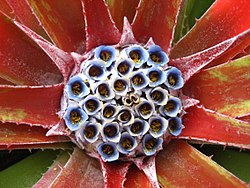| Fascicularia | |
|---|---|
 | |
| Fascicularia bicolor | |
| Scientific classification | |
| Kingdom: | Plantae |
| Clade: | Tracheophytes |
| Clade: | Angiosperms |
| Clade: | Monocots |
| Clade: | Commelinids |
| Order: | Poales |
| Family: | Bromeliaceae |
| Subfamily: | Bromelioideae |
| Genus: | Fascicularia Mez |
| Species: | F. bicolor |
| Binomial name | |
| Fascicularia bicolor | |
| Synonyms [1] | |
| |
Fascicularia is a monotypic genus of flowering plants in the pineapple family Bromeliaceae, subfamily Bromelioideae. The genus name is from the Latin fasciculus (bundle) and arius (pertaining to). [2]
Contents
Only one species is known, Fascicularia bicolor. It is endemic to Chile [1] and reportedly naturalized in France and the extreme south and west of Great Britain. [3] In the wild, all Fascicularias are saxicolous (growing on rocks) or epiphytes. [4] [5]
It is cultivated in gardens for the dramatic bright crimson colour of its leaves contrasting with the blue inflorescence. [6]
The edible fruits are similar to those of the species Greigia sphacelata , but smaller; They are consumed in the same way as these. [7]